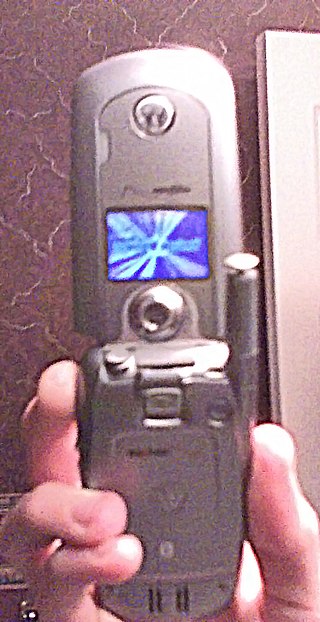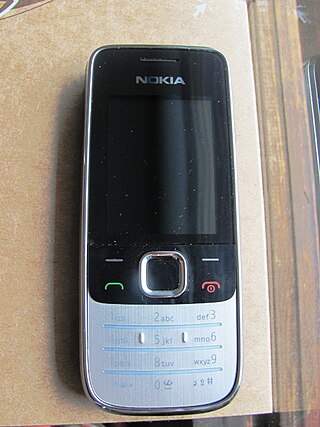The O2 Xda brand was a range of Windows Mobile PDA phones, marketed by O2, developed by O2 Asia and manufactured by multiple OEMs (mainly HTC, Quanta and Arima). The first model was released in June 2002. The last models came to market in 2008. The "X" represents convergence of voice and information/data within one product; the "DA" stands for "Digital Assistant", as in PDA. The name of XDA Developers is derived from it.
The Motorola ROKR, the first version of which was informally known as the iTunes phone, was a series of mobile phones from Motorola, part of a 4LTR line developed before the spin out of Motorola Mobility. ROKR models were released starting in September 2005 and ending in 2009. They were notable for incorporating support of media player features.

The Motorola E815 is a clamshell mobile phone that is the successor to the V710. It includes the following features:

The Motorola Q is a Windows Mobile smartphone designed and manufactured by Motorola. It was first announced in the summer of 2005 as a thin device with a similar design to the Motorola Razr. The Motorola Q was first released in the United States on May 31, 2006, initially on the Verizon Wireless network, followed by Sprint in early January 2007 and Amp'd Mobile in April 2007.
The Motorola E770 mobile phone is a 3G phone that operates primarily on the third generation phone network; however, it can be downscable to GPRS 2.5 and below if required.
Motorola Krzr, known as the "Canary" before its release, is a series of clamshell/flip mobile phones by Motorola, and was one of the series in the 4LTR line. It consisted of the K1 (2006) followed by the K3 (2007). As a clamshell/flip phone, the Krzr is longer but narrower than the Motorola Razr V3.
The Motorola Ming is a series of smartphones from Motorola, sold in Hong Kong and mainland China only. It is one of the series in the 4LTR line.

The Palm Treo 700wx is a smartphone offered by Sprint, Alltel and Verizon as an update to Palm's earlier release of the Verizon-only Treo 700w. It is Palm's second Windows Mobile Treo.

The BlackBerry Pearl was a series of smartphones developed by Research In Motion, and was the first BlackBerry device with a camera and media player. It was originally released on September 12, 2006. T-Mobile was the first US carrier to release the phone as a carrier device. The last BlackBerry Pearl released was the 9100 series on May 13, 2010. After this model was cleared out, RIM discontinued the Pearl series.
The Motorola Slvr is a former series of candybar mobile phones from Motorola, and was one of the series in the 4LTR line. The first phones were released in early 2005. Inspired by the Razr, they were designed to be very thin and lightweight.
The Motorola Razr2 (often stylized as RAZR2) is a series of clamshell/flip mobile phones from Motorola, and is one of the series in the 4LTR line. It is the successor to the popular Razr series. The Razr2 is 2 mm thinner than its predecessor but slightly wider. Some versions feature Motorola's MotoMagx operational platform, based on the MontaVista Linux OS. The Razr2 was made available on every US carrier, and EVDO, GSM, and HSDPA versions were released by late 2007.
The Nokia 3600 slide is a mobile phone by Nokia that was released in August 2008. The phone runs the Series 40 3rd Edition platform. This is classed as the 'low end version' of the Nokia 6600 slide, its major difference being the lack of 3G support.

The HTC Touch Pro is a smart phone from the Touch series of Internet-enabled Windows Mobile Pocket PC smartphones designed and marketed by HTC Corporation of Taiwan. It is an enhanced version of the HTC Touch Diamond with the addition of a left-side slide-out QWERTY keyboard, a microSD card slot, and a camera flash. The Touch Pro smartphone's functions include those of a camera phone and a portable media player in addition to text messaging and multimedia messaging. It also offers Internet services including e-mail, instant messaging, web browsing, and local Wi-Fi connectivity. Depending on its market, it is a quad-band GSM or quad-band UMTS phone with GPRS, EDGE, UMTS, HSDPA, and HSUPA or a tri-band CDMA phone with 1xEV-DO Rev A. All versions feature TouchFLO 3D — a new enhanced version of the TouchFLO interface, unique only to the latest Touch series. In March 2009, HTC announced a new version, the Touch Pro2 which has a larger screen (3.6") and a redesigned slide out QWERTY keyboard with spaces between the keys.

The BlackBerry Tour is a consumer smartphone developed by BlackBerry Limited and is part of the 9600 device series. This high-end messaging phone combines the multimedia features of the Curve with the global roaming of the 8830, plus a higher-resolution display, 3.2 megapixel auto-focus camera, overseas 3G data and faster EVDO Rev. A data in the United States and Canada. Other key features include voice calling, video capture, a 3.5mm audio jack, a microSD slot, push email, a QWERTY keyboard, Bluetooth, and GPS navigation. The BlackBerry Tour was released on July 12, 2009. In 2010, the 'Tour 2' refresh was re-branded as the Blackberry Bold 9650 when RIM decided to merge the GSM and CDMA2000 variants under the same brand.
The LG Incite is an Internet-enabled Windows Mobile Pocket PC smartphone designed and marketed by LG of Korea.

The Nokia 2730 classic is a Nokia Quad-band GSM/UMTS 3G cell phone that includes a camera, FM radio, Bluetooth, music and video player, as well as several internet-based applications.

The LG Cosmos is a slider mobile phone made by LG Electronics. The phone is available in both a touch screen and non-touch screen model. It became available on Verizon Wireless in Q1 2010, and was replaced by LG Cosmos 2 in July 2011. The phone has 1.3-megapixel camera, VZ Navigator, Voicemail, Media Center, QWERTY keyboard and SMS and MMS messaging.

The Nokia 2690 is a mobile phone released by Nokia in March 2010. It operates on GSM quad band frequency 850, 900, 1800 and 1900 MHz, with automatic switching between frequencies. It has dimensions of 107.5 × 45.5 × 13.8 mm and weighs 80.7 grams.

The Motorola Droid Bionic is an Android-based, 4G LTE-capable smartphone designed by Motorola. It was originally scheduled for release in Q2 2011 but was delayed, eventually being released on 8 September 2011.










